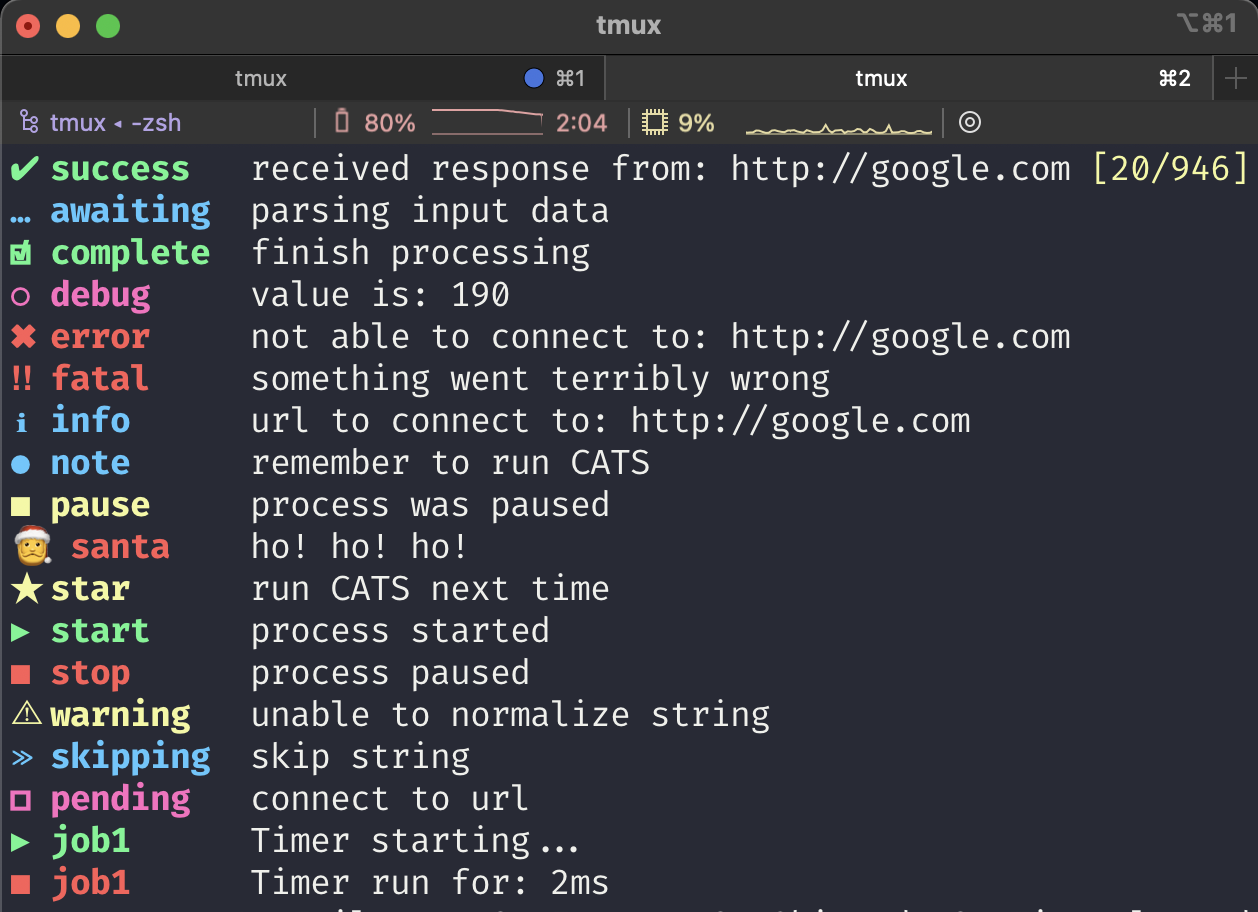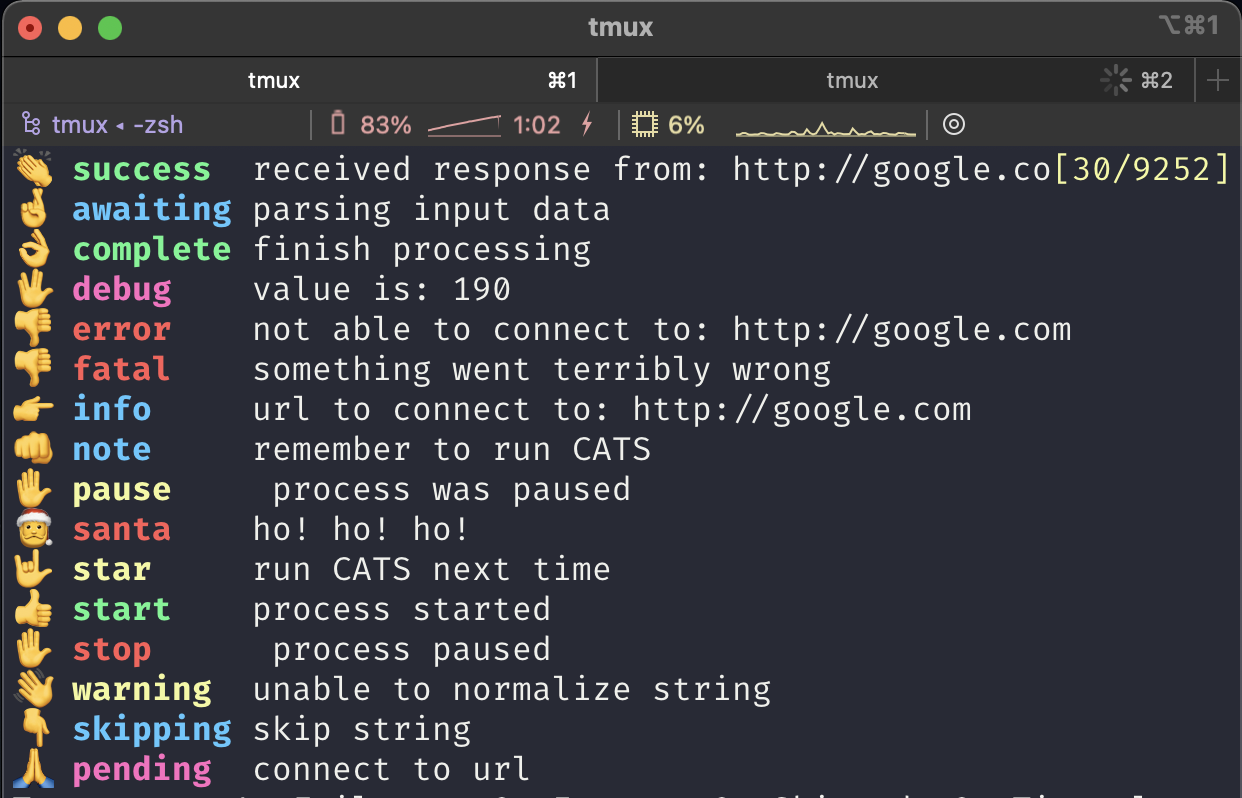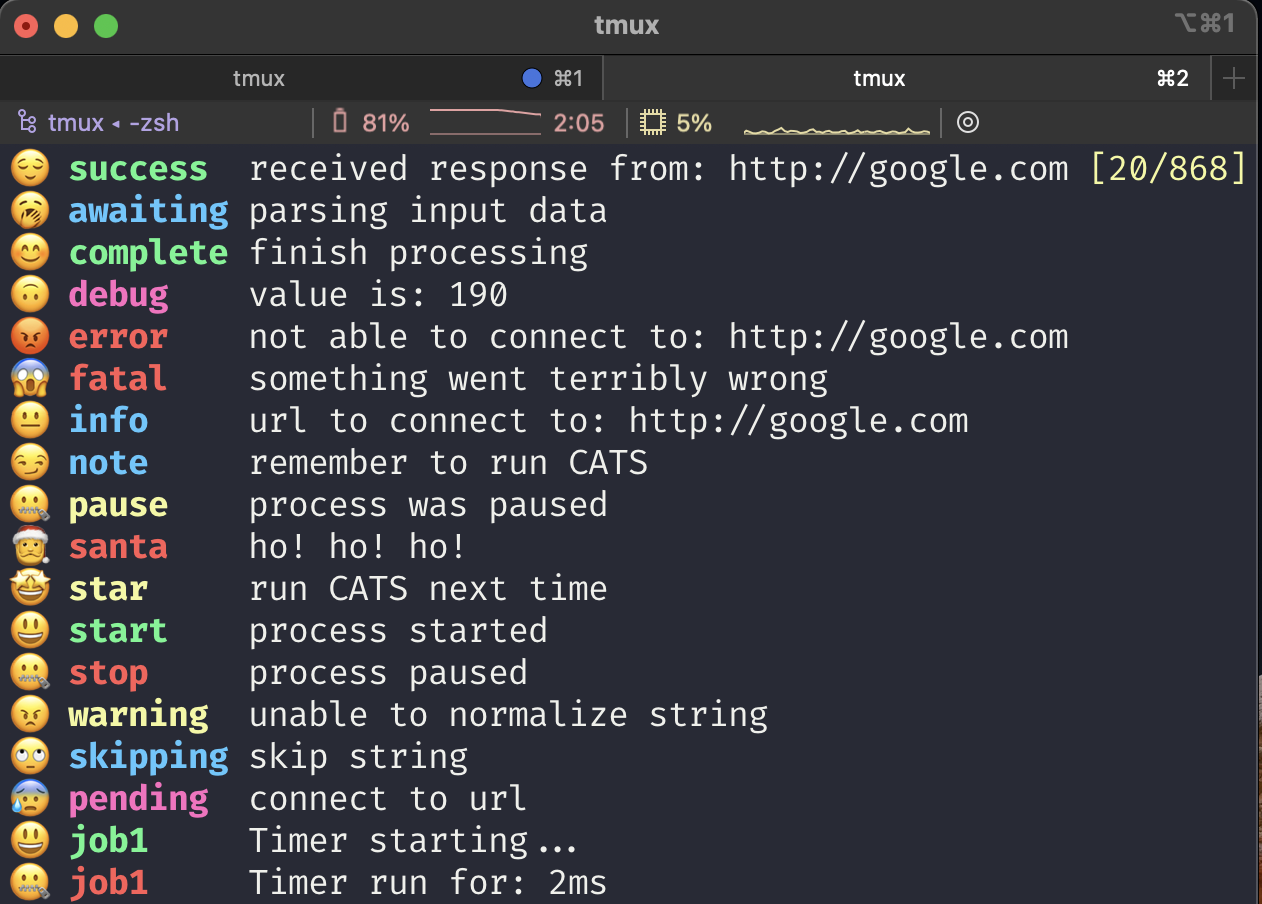Pretty Logger for Java is a slf4j decorator that enables pretty printing
using ANSI formatting
through jansi. PL4J can be used either through
Markers or simply prefixing the log messages.
Add it as a Maven dependency in your pom.xml file:
<dependency>
<groupId>io.github.ludovicianul</groupId>
<artifactId>pretty-logger</artifactId>
<version>LATEST</version>
</dependency> public class TestClass {
public static void main(String... args) {
PrettyLogger prettyLogger = PrettyLoggerFactory.getLogger(TestClass.class); //same declaration as SLF4J
prettyLogger.success("received response from: {}", "http://google.com");
prettyLogger.awaiting("parsing input data");
prettyLogger.complete("finish processing");
prettyLogger.debug("value is: {}", "190");
prettyLogger.error("not able to connect to: {}", "http://google.com");
prettyLogger.fatal("something went terribly wrong");
prettyLogger.info("url to connect to: {}", "http://google.com");
prettyLogger.note("remember to run CATS");
prettyLogger.pause("process was paused");
prettyLogger.santa("ho! ho! ho!");
prettyLogger.star("run CATS next time");
prettyLogger.start("process started");
prettyLogger.stop("process paused");
prettyLogger.warning("unable to normalize string");
}
}PL4J can be used either through Markers or as simple prefix for the messages.
Depending on your logging implementation you can choose one or the other.
This can be configured through the pl4j.use-markers property. Default value is true.
The way you set this property will influence how the log patterns should be defined:
- when using Markers, make sure the log pattern also includes the
%marker - when not using Markers, it's enough to just include the
%msg
This is a sample logback configuration file that was used to display the above console output when using Markers (i.e. pl4j.use-markers = true):
<?xml version="1.0" encoding="UTF-8"?>
<configuration debug="false">
<statusListener class="ch.qos.logback.core.status.NopStatusListener"/>
<appender name="STDOUT" class="ch.qos.logback.core.ConsoleAppender">
<withJansi>true</withJansi>
<encoder class="ch.qos.logback.classic.encoder.PatternLayoutEncoder">
<pattern>%-27marker %msg%n</pattern>
</encoder>
</appender>
<root level="trace">
<appender-ref ref="STDOUT"/>
</root>
</configuration>If you want to achieve the same thing using prefixes, you need to set the following properties in the pl4j.properties:
pl4j.use-markers=false
pl4j.prefix-format=%1$-29sAnd the log pattern will need to remove the %marker:
<?xml version="1.0" encoding="UTF-8"?>
<configuration debug="false">
<statusListener class="ch.qos.logback.core.status.NopStatusListener"/>
<appender name="STDOUT" class="ch.qos.logback.core.ConsoleAppender">
<withJansi>true</withJansi>
<encoder class="ch.qos.logback.classic.encoder.PatternLayoutEncoder">
<pattern>%msg%n</pattern>
</encoder>
</appender>
<root level="trace">
<appender-ref ref="STDOUT"/>
</root>
</configuration>The next sections will use the name Markers generically, as a way to identify both the Markers and prefixes cases. You can get back to this section and the Marker vs Prefix section to see how you can configure any of them.
PL4J uses the following mapping between the SLF4J log levels and the markers:
| SLF4J Log Level | PL4J Marker |
|---|---|
debug |
debug |
info |
awaiting, complete, info, fav, note, pause, pending, santa, star, start, stop, success, skipping, time, timeEnd |
warn |
warning |
error |
error, fatal |
You can override the default Markers as follows:
import io.github.ludovicianul.prettylogger.config.level.PrettyMarker;
import io.github.ludovicianul.prettylogger.PrettyLogger;
import io.github.ludovicianul.prettylogger.config.level.ConfigFactory;
import java.util.HashMap;
public class TestClass {
public static void main(String... args) {
PrettyLogger prettyLogger = PrettyLoggerFactory.getLogger(TestClass.class);
//option 1
PrettyMarker config = ConfigFactory.error().label("err");// we change the label to `err` instead of `error`
prettyLogger.log(config, "this is an error");//note that we use log() instead of error()
//option 2
Map<PrettyMarker.ConfigKey, Object> configMap = new HashMap<>();
configMap.put(PrettyMarker.ConfigKey.UNDERLINE, true);
prettyLogger.skip(configMap, "skip processing for id 1");
}
}You can override both the symbol and the label. The following flags can also be configured (all booleans):
boldunderlineshowLabelshowSymboluppercaseLabel
The flags can be configured both individually, for each marker:
import io.github.ludovicianul.prettylogger.config.level.PrettyMarker;
import io.github.ludovicianul.prettylogger.PrettyLogger;
import io.github.ludovicianul.prettylogger.config.level.ConfigFactory;
public class TestClass {
public static void main(String... args) {
PrettyLogger prettyLogger = PrettyLoggerFactory.getLogger(TestClass.class);
PrettyMarker config = ConfigFactory.error().bold(false).underline(true).showLabel(true).showSymbol(true).uppercaseLabel(true);
prettyLogger.log(config, "this is an error");//note that we use log() instead of error()
}
}As well as globally as shown in Global Configuration
You can configure the above flags globally through a file called pl4j.properties which must be present in the
classpath. The following properties can be used to change the flag values (all booleans:
pl4j.show-labelspl4j.show-symbolspl4j.boldpl4j.underlinepl4j.themepl4j.uppercase-labelpl4j.use-markerspl4j.prefix-format
If no global or individual configuration is supplied the default values are as follows:
bold = trueunderline = falseshowLabel = trueshowSymbol = truetheme = defaultuppercaseLabel = falseuse-markers = trueprefix-format = %1$-29s
PL4J supports themes, meaning that you can create your own combination of symbol, label and color for
each MarkerType. In order to do this you must create a file named pl4j-themename.theme following the example of
the default theme, place it
into the classpath and configure the theme name in pl4j.properties as follows:
pl4j.theme=themenameIf PL4J doesn't find the pl4j-themename.theme inside the classpath it will default to the default theme. This is the
list of out-of-the-box supported themes:
- default: https://github.com/ludovicianul/pl4j/blob/master/src/main/resources/pl4j-default.theme
- gestures: https://github.com/ludovicianul/pl4j/blob/master/src/main/resources/pl4j-gestures.theme
- emojis: https://github.com/ludovicianul/pl4j/blob/master/src/main/resources/pl4j-emojis.theme
You can also automatically measure the duration of specific tasks using timers. This is an example on how to use timers:
import io.github.ludovicianul.prettylogger.config.level.PrettyMarker;
import io.github.ludovicianul.prettylogger.PrettyLogger;
import io.github.ludovicianul.prettylogger.config.level.ConfigFactory;
public class TestClass {
public static void main(String... args) {
PrettyLogger prettyLogger = PrettyLoggerFactory.getLogger(TestClass.class);
prettyLogger.time("job1");
// stuff happening
prettyLogger.time("job1");
//other stuff happening
prettyLogger.timeEnd("job1");
}
}If you call the time() method multiple times using the same timer key, pl4j will display interim timers between the starting time, and the moment you call the method again.
The above program will print something like:
👍 job1 Timer starting...
✋ job1 Interim timer run for: 2004ms
✋ job1 Timer run for: 4506msIf NO_COLOR is set, then all ANSI styling is disabled.
Inspired by signale.


